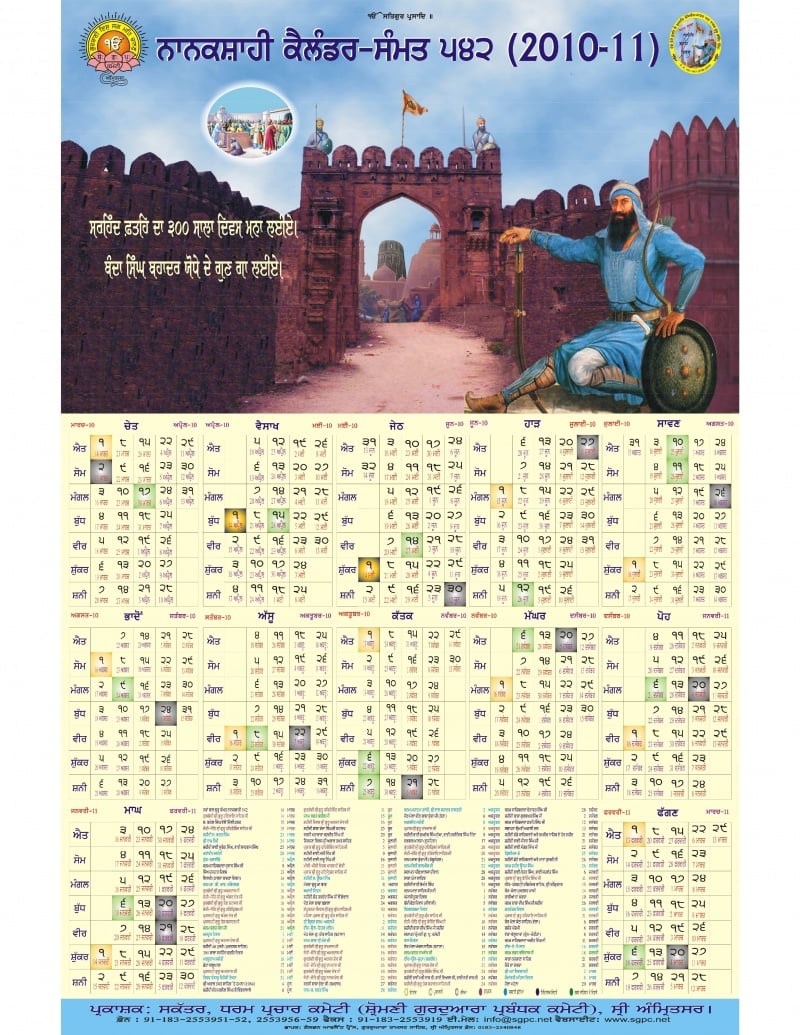Nanakshahi year
The Nanakshahi (Punjabi: ਨਾਨਕਸ਼ਾਹੀ, nĝnakashĝhī) calendar is a tropical solar calendar that was adopted by the Shiromani Gurdwara Prabhandak Committee to determine the dates for important Sikh events.[1] It was designed by Pal Singh Purewal to replace the Saka calendar and has been in use since 1998. Since 1998, amongst the critics, no-one has come forward with suggestions of specific changes, other than to suggest that the Sikhs should revert back to the Vikrami calendar. The epoch of this calendar is the birth of the first Sikh Guru, Nanak Dev in 1469. The Nanakshahi New Year's Day falls annually on what is March 14 in the Gregorian calendar Western calendar.[1]
Year one is the year of Guru Nanak's birth (ie: 1469 CE); the common era year 2010 CE is Nanakshahi year 541. The Nanakshahi year 1 runs from March 14, 1469 to March 13, 1470; it is the first year of Guru Nanak's birth.
Conversion to Western calendar
The following table gives the Nanakshahi calendar year and its translation to the Western calendar:
| Nanakshahi year | Western calendar |
|---|---|
| 544 | 14 March 2012 to 13 March 2013 |
| 543 | 14 March 2011 to 13 March 2012 |
| 542 | 14 March 2010 to 13 March 2011 |
| 541 | 14 March 2009 to 13 March 2010 |
| 540 | 14 March 2008 to 13 March 2009 |
| 530 | 14 March 1998 to 13 March 1999 |
| 520 | 14 March 1988 to 13 March 1989 |
| 510 | 14 March 1978 to 13 March 1979 |
| 500 | 14 March 1968 to 13 March 1969 |
| 401 | 14 March 1869 to 13 March 1870 |
| 301 | 14 March 1769 to 13 March 1770 |
| 231 | 14 March 1699 to 13 March 1700 |
| 201 | 14 March 1669 to 13 March 1670 |
| 101 | 14 March 1569 to 13 March 1570 |
| 1 | 14 March 1469 to 13 March 1470 |
To obtain the Nanakshahi year, from the common era year take away 1468; this applies at 14 March of any common era year. So for 14 March 2050 the Nanakshahi year is 2050 - 1468 = 582 Nanakshahi.
Popularity of the calendar
The calendar is accepted in about 90% of the gurdwaras throughout the world. There is some controversy about the acceptance of the calendar among certain orthodox sectors of the Sikh world. Some orthodox organizations and factions have not accepted it including many orders dating from the time of the Gurus such as Damdami Taksal, Buddha Dal Nihungs, Takhats etc.
Features of the new calendar
- a tropical solar calendar
- called Nanakshahi after Guru Nanak (founder of Sikhism)
- year one is the year of Guru Nanak's birth (1469 CE). * 2010 CE is NANAKSHAHI 541 *
- uses most of the mechanics of the Western calendar
- year length is same as Western calendar (365 days 5 hours 48 minutes 45 seconds)
- contains 5 months of 31 days followed by 7 months of 30 days
- leap year every 4 years in which the last month (Phagun) has an extra day
- Approved by Akal Takht in 2003 but later amended
See also
- Nanakshahi calendar
- Sikh Calendar
- Gregorian Calendar
- Forthcoming Events
- Timeline of Sikhism
- History
- History of Punjab
- Baramaha Calendar-Punjab and Sind Bank
- Bara Maha
External links
- Pal Singh Purewal's website
- Nanakshahi Calendar 2003
- Add these calendar dates to your eCalendar/Email
- Download Nanakshahi 542 (2010-11) calendar
- sikhcoalition.org
- Sikhism calendar
- Birth Date of Guru Nanak Sahib
- SGPC Nanakshahi Calendar
- Add Nanakshai Calendar to your eCalendar/Email
- Nanakshahi calendar in Google
Videos
- Pal Singh Purewal with Prof Gurvinder Singh Dhaliwal - Part 1 - Part 2 - Part 3 - Part 4 - Part 5 - Part 6 - Part 7 - Part 8
- Pal Singh Purewal 9 Autobiography
- You Tube search Nanakshahi calendar
Controversy about the calendar 2011-2012
- Lobbying Continues Against Changes to Nanakshahi Calendar
- Nanakshahi calendar: Jathedars adopt changes, final call by SGPC
References
- ^ a b What is the Sikh Nanakshahi calendar http://www.allaboutsikhs.com/sikh-way-of-life/the-sikh-nanakshahi-calendar-3.html allaboutsikhs.com Retrieved 2008-05-09
| These are the Twelve Months of the Nanakshahi Calendar | |||||||||||
| 1 | 2 | 3 | 4 | 5 | 6 | 7 | 8 | 9 | 10 | 11 | 12 |
| Chet | Vaisakh | Jeth | Harh | Sawan | Bhadon | Assu | Katak | Maghar | Poh | Magh | Phagun |

